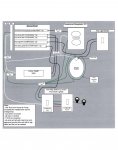Now that my grading is done, I'm ready to tackle the electrical. Had a $1500 quote to do the job (not including the timer and trench work), so I need to save where I can, plus I like a challenge..
I made this diagram to try and understand what's needed.
Any comments? First time working with THHN wires.
- all the neutrals and grounds will be joined together at an outdoor pool-approved junction box, and pigtailed out as necessary
- I upgraded the needed wire size for the pump, not sure if 12g. is sufficient for the convenience out light and lights (due to the 160' run)
- can the pool light and deck lights all be on the same circuit/breaker? would 12g ok?
- after speaking with the inspector regarding an outdoor subpanel, I'm going this route instead. They want a permanent covered structure to cover the panel and I have future plans for a shed/cabana that I don't want them to know about.
- I'm assuming the ground wire can be insulated and green; also not sure if code requires certain wire colors; someone mentioned it's preferred
I made this diagram to try and understand what's needed.
Any comments? First time working with THHN wires.
- all the neutrals and grounds will be joined together at an outdoor pool-approved junction box, and pigtailed out as necessary
- I upgraded the needed wire size for the pump, not sure if 12g. is sufficient for the convenience out light and lights (due to the 160' run)
- can the pool light and deck lights all be on the same circuit/breaker? would 12g ok?
- after speaking with the inspector regarding an outdoor subpanel, I'm going this route instead. They want a permanent covered structure to cover the panel and I have future plans for a shed/cabana that I don't want them to know about.
- I'm assuming the ground wire can be insulated and green; also not sure if code requires certain wire colors; someone mentioned it's preferred



